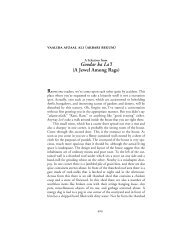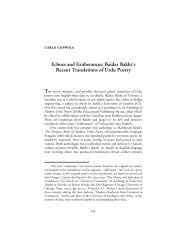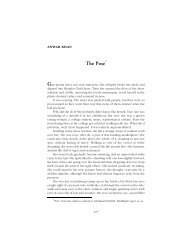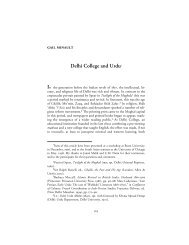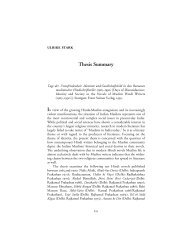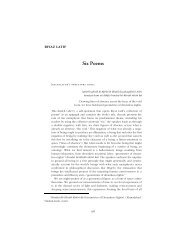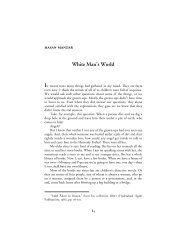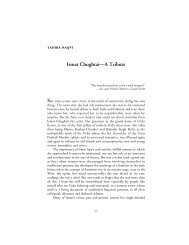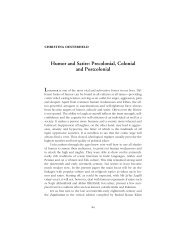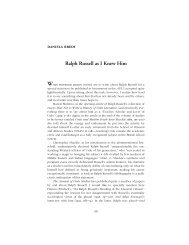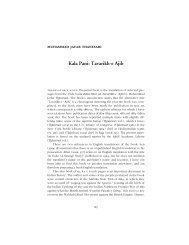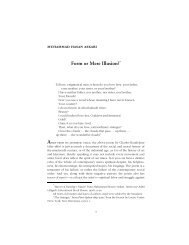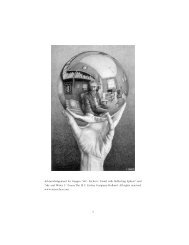Politics, Public Issues and the Promotion of Urdu Literature: Avadh ...
Politics, Public Issues and the Promotion of Urdu Literature: Avadh ...
Politics, Public Issues and the Promotion of Urdu Literature: Avadh ...
You also want an ePaper? Increase the reach of your titles
YUMPU automatically turns print PDFs into web optimized ePapers that Google loves.
ULRIKE STARK • 69The second success factor concerned <strong>the</strong> pr<strong>of</strong>essional management <strong>of</strong><strong>the</strong> paper. AA was one <strong>of</strong> <strong>the</strong> first <strong>Urdu</strong> papers to be run along soundcommercial lines. This implied that <strong>the</strong> paper partly financed itselfthrough advertisements. Compared to British newspapers at <strong>the</strong> time,which made larger incomes from advertising than from sales, 8 <strong>the</strong> proportion<strong>of</strong> space given to advertisements was relatively small. A typical issue<strong>of</strong> AA in 1871, for example, comprised sixteen pages <strong>of</strong> which an average<strong>of</strong> four would be given to advertising. Subsequently advertising came toaccount for an increasingly important part <strong>of</strong> <strong>the</strong> paper’s revenue. In 1879,<strong>the</strong> rate obtaining for occasional small advertisements was 2 annas per line<strong>and</strong> column. Rates for regular commercial advertisements depended onhow <strong>of</strong>ten an ad was placed in <strong>the</strong> paper <strong>and</strong> ranged from Rs. 12 forinsertion once a month to Rs. 60 for insertion six times a month. 9 By thattime AA carried regular advertisements for br<strong>and</strong>ed goods <strong>and</strong> for patentmedicines such as <strong>the</strong> widely advertised Holloway’s pills <strong>and</strong> ointments or<strong>the</strong> “celebrated medicines” <strong>of</strong> one Dr. De Roos, <strong>of</strong> which <strong>the</strong> publishinghouse acted as a sole distributor. Local firms such as Murray & Co., alarge retail company selling wine <strong>and</strong> general merch<strong>and</strong>ise, <strong>and</strong> <strong>the</strong>Shaikh Haji Muhammad Bakhsh Company, a contractor <strong>of</strong> tents <strong>and</strong>uniforms, started to place regular full-page ads in <strong>the</strong> paper. The NKP, <strong>of</strong>course, also used <strong>the</strong> paper as a cheap medium to extensively advertise <strong>and</strong>invite subscriptions for its own book publications. In <strong>the</strong> early days <strong>of</strong>AA, announcements <strong>of</strong> important publications such as Gh≥lib’s PersianKulliy≥t or his Q≥πi‘-e Burh≥n would feature prominently on its front page(AA <strong>of</strong> 1 January 1862). Later, such notices were relegated to <strong>the</strong> interioror back <strong>of</strong> <strong>the</strong> paper but still appeared so frequently that <strong>the</strong> Delhi-basedNuΩratu ’l-Akhb≥r was prompted in 1876 to accuse AA <strong>of</strong> being totally“self-interested”: “The editor has been instructed not to write any articlebeneficial to <strong>the</strong> public, but only to print reviews <strong>of</strong> <strong>the</strong> books [publishedby] <strong>the</strong> press.” 10Sanjay Joshi, Fractured Modernity: Making <strong>of</strong> a Middle Class in Colonial NorthIndia (Oxford: Oxford University Press, 2001), pp. 38–9.8 Lucy Brown, Victorian News <strong>and</strong> Newspapers (Oxford: Clarendon Press,1985), p. 16.9 See Fihrist-e Kutub-e Maπba‘-e Munshµ Navalkishår (Lucknow: Naval KishorePress, 1879), p. 4.10NuΩratu ’l-Akhb≥r <strong>of</strong> 1 August 1876; quoted in Imd≥d ¿≥birµ, T≥rµkh-e¿a√≥fat-e Urd∑, vol. 2 (Delhi: Jadµd Printing Press, 1953), pp. 97–8.



